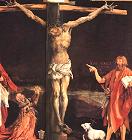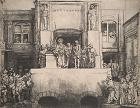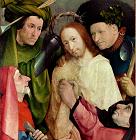
Feature Archive |
The Passion of Christ as depicted in great art
The "Look" of Mel Gibson's The Passion of the Christ |
|
In answering this question, we are lucky to have an interview with the film's camerman Caleb Deschanel in the March issue of American Cinematographer. In that interview he explains that while the film follows the traditional sequence of the passion in the liturgy, the gruesome depiction of the violence done to Christ has never before been represented in this way either in the history of Western art, or in the previous cinematic versions. Neither the Hollywood productions such as King of Kings and The Greatest Story Ever Told, nor the European efforts such as Pasolini's The Gospel According to St. Matthew, ever sought to show the full extent of Christ's suffering or the violent details of his last hours. Deschanel says in the interview that none of the previous efforts really depicted the details of the flagellation and the other violence that was done. He states: I did a lot of research going into this film, and I didn't find much imagery like that. There are things in the film that you can find in certain artistic representations, but it's rare to see images of Christ with severe wounds from the flagellation. Rare indeed. But in fact there is one artist who presents the broken and beaten body of Christ on the cross and that is Matthias Grünewald whose Isenheim Altarpiece in Colmar focuses on this aspect of the story. But even here the violence done to Christ's body is to be seen only when the altarpiece is closed. When it is opened up it reveals the affirmative images of the joyous annunciation of Mary, Jesus' happy infancy with a concert of angels, and an awe-filled scene of the ascension of Jesus to the "right hand of God." Such a context is important when one is showing such a powerfully negative image. Deschanel goes on to identify one painter above all as the source of the imagery in the film and this is Caravaggio. He and Gibson studied this artist's work both directly and in reproduction with a view to the imagery of their film. As I have discussed in a previous articles, Caravaggio is famous for his dramatic realism (his use of working class people with wonderfully plebian faces and with dirty feet as his models) and for his equally intense and theatrical lighting and compositions. But Gibson and Deschanel did not attempt to reenact specific Caravaggio paintings in their film so much as to use Caravaggio as a source for the film's general appearance and human "look." Deschanel says that Caravaggio's work inspired the film as much in terms of the faces he used in those paintings as it did in terms of the lighting and composition. Those faces probably inspired the casting of the film. I keep looking at all the faces that were found by Mel and the casting director, Shaila Rubin, and they're really quite extraordinary.So the thinking behind the film was that the power of its images would reside not so much in the graphic violence itself but in the portrayal of the human faces reacting to the violence before them. Deschanel explains that: "You want to look at these people because they have readable faces." He says of himself that "I'm drawn to the human face because it's so powerful." While people think "cinematographers are drawn to movies because they give us a vast canvas on which we can create big epics," they would be wrong in his particular case because he has "always been drawn to movies by the actors and the chance to be there at the moment of a great performance."
In terms of other visual sources, the court of fat and decadent Herod seems inspired by representations in previous films. And Gibson alludes to the Shroud of Turin when Christ is taken down from the cross. In fact the look of Christ, and according to news reports even the casting of Jim Caviezel in the role, were inspired by the visual image of the Shroud. Deschanel explains that what shaped him as a great cameraman was his education and especially self-education. He has always been in the habit of going to museums with a view to understanding the way in which the great masters portrayed human emotions. I studied art history in school and I've been to a lot of museums, and the paintings that really interest me are the ones that feature good performances. I'm drawn to that element even more than I am to the graphics or the lighting. What I took from the paintings was not so much a specific way of representing light or creating compositions, but more emotional content. For example, Géricault's The Raft of the Medusa has a certain motion toward defeat and inevitable death. Mel's desire to capture that type of emotion is what made us go right in close with the characters and try to make the story intimate and real.So it is clear from the above that in order to fully appreciate the creative process that went into the making of a film like The Passion of the Christ, one has to consider the legacy of Western art that lies behind it. Regardless of the vigorous and sometimes acrimonious controversy surrounding the religious implications of the film, we should also see it as a cinematic portal through which the moviegoer can pass to some of the greatest artistic imagery in the history of Western culture.
|
|
||||||||||||||
Past Articles
2004
The Importance of Being Odd: Nerdrum's Challenge to Modernism, by Paul A. Cantor
2003
Advent Calendar 2003, narrated by Joseph Phelan
If Paintings Could Talk: Paul Johnson's Art: A New History, by Joseph Phelan
Mad Max [Max Beckmann], by Joseph Phelan
Marsden Hartley: The Return of the Native, by Joseph Phelan
Jean-Antoine Houdon: Sculptor of the Enlightenment, by Joseph Phelan
Frederic Remington's Nocturnes, by Joseph Phelan
Magnificenza! Titian and Michelangelo, Manet and Velazquez, by Joseph Phelan
Masterful Leonardo and Graphic Dürer, by Joseph Phelan
Favorite Online Art Museum Features, by Joseph Phelan
Studies for Masterpieces, by John Malyon
2002
Portrait of the Artist as a Serial Killer, by Joseph Phelan
Renoir's Travelling, Bonnard's "At Home", by Joseph Phelan
The Philosopher as Hero: Raphael's The School of Athens, by Joseph Phelan
The Greatest Works of Art of Western Civilization
Celebrating Heroes; Celebrating Benjamin West, by Joseph Phelan
Chasing the Red Deer into the American Sublime (Education and the Art Museum, Part II), by Joseph Phelan
Planning Your Summer Vacation, by Joseph Phelan
Education and the Art Museum, Part I, by Joseph Phelan
Unsung Griots of American Painting, by Joseph Phelan
The British Museum COMPASS Project, interview by Joseph Phelan
Robert Hughes, Time Magazine Art Critic: Biography and Writings
2001
Software review: Le Louvre: The Virtual Visit on DVD-ROM, by Joseph Phelan
Tragedy and Triumph at Arles: Van Gogh and Gauguin, by Joseph Phelan
Her Last Bow: Sister Wendy in America, by Joseph Phelan
Love, Death and Resurrection: The Paintings of Stanley Spencer, by Joseph Phelan
Who is Rodin's Thinker?, by Joseph Phelan
Celebrations North and South, by Joseph Phelan
Rubens and his Age, by Joseph Phelan
Great Reproductions of Great Paintings
The Passion of Christ, by Joseph Phelan
Edouard Manet: Public Spaces, Private Dreams, by Joseph Phelan
Henry Moore and the British Museum: The Great Conversation, by Joseph Phelan
2000
Notorious Portraits, Part II, by John Malyon
Notorious Portraits, Part I, by John Malyon
The Other Michelangelo, by Joseph Phelan
The Art of Drawing, by Joseph Phelan
Poussin and the Heroic Landscape, by Joseph Phelan
Great Art Museums Online, by Joseph Phelan
Venetian Painting and the Rise of Landscape, by Joseph Phelan
Forbidden Visions: Mythology in Art, by Joseph Phelan
Themes in Art: The Passion of Christ, by Joseph Phelan
Web site review: Christus Rex
Web site review: National Gallery of Art, Washington, D.C., by Joseph Phelan
Online exhibit review: Inuit Art: The World Around Me, by John Malyon
Poll: Who is Producing the Most Interesting Art Today? (Results)
Poll: Who is Producing the Most Interesting Art Today? (Part II)
1999
Poll: Who is Producing the Most Interesting Art Today? (Part I)
Spotlight on The Louvre Museum
Spotlight on Impressionism
Spotlight on Optical Art
Spotlight on Animals in Art
Spotlight on Surrealism
Spotlight on Sculpture
Spotlight on Women in the Arts
Spotlight on The Golden Age of Illustration
Spotlight on Vincent van Gogh
Spotlight on Great Art






